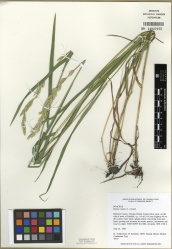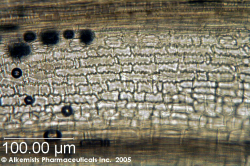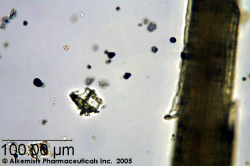From AHPA Botanical Identity References Compendium
(Difference between revisions)
|
|
| Line 13: |
Line 13: |
| | | | |
| | =Botanical Voucher Specimen= | | =Botanical Voucher Specimen= |
| | + | |
| | + | {{Media |cat=Voucher |
| | + | |
| | + | | source=MOBOT, Tropicos.org |
| | + | | mainimage=Elymus repens Tropicos 100010959.jpg |
| | + | | companyimage=TropicosLogo.gif |
| | + | | companyURL=http://www.tropicos.org/Image/100010959 |
| | + | | reference=Tropicos.org. Missouri Botanical Garden. 19 Mar 2014 <http://www.tropicos.org/Image/100010959> |
| | + | |
| | + | | }} |
| | + | |
| | =Organoleptic Characteristics= | | =Organoleptic Characteristics= |
| | {| border=1 | | {| border=1 |
Revision as of 04:16, 20 March 2014
Nomenclature
Elymus repens (L.) Gould Poaceae
Syn. Agropyron repens (L.) P. Beauv.; Elytrigia repens (L.) Desv. ex B.D. Jackson; Triticum repens L.
Standardized common name (English): couch grass
Botanical Voucher Specimen
 |
|

Source: MOBOT, Tropicos.org[1]
|
Organoleptic Characteristics
| [Couch Grass (rhizome) ...] odor slight, aromatic; taste sweetish. [...]
No odor; taste slightly sweet.
Source: United States Dispensatory (1918) [2]
|
|
|
|
|
Macroscopic Characteristics
| Couch Grass is the dried rhizome, freed from remains of leaves and rootlets.
It is specifically characterized by its creeping rootstock, the leaves being flat, thin and finely veined, and the flowering glumes being glabrous or scabrous.
Usually in pieces from 4 to 12 mm. in length and from 1 to 2.5 mm. in diameter; externally light yellow or yellowish-brown, longitudinally furrowed, smooth, lustrous, nodes with circular leaf-scars, a few root-scars and occasional slender roots; fracture tough, fibrous; internally lemon-yellow and with a large, hollow pith. [...] Roots filiform, irregularly branching, attaining a length of about 5 cm. and not more than 0.5 mm. in thickness, light brown or yellowish-brown, frequently covered with long root hairs.
Rhizome pale yellow, rigid, from two to two and a half millimetres in diameter, usually in pieces from three to six millimetres long. Strongly furrowed longitudinally, hollow except at the nodes. Contains no starch.
Source: United States Dispensatory (1918) [3]
|
|
|
|
|
Microscopic Characteristics
| Under the microscope, transverse sections of Triticum show a single layer of strongly lignified epidermal cells; a hypodermis of from 3 to 6 rows of more or less polygonal cells with strongly lignified walls; a cortex of from 10 to 16 rows of thin-walled parenchyma cells, occasionally with nearly spherical starch grains about 0.005 mm. in diameter, or with irregular masses of a more or less soluble carbohydrate; among the parenchyma cells and near the hypodermis occur small, widely separated fibro-vascular bundles, each with a closed sheath of sclerenchymatous fibers; an endodermis, the lateral and inner walls of the cells moderately thickened, strongly lignified and somewhat porous; several layers of sclerenchymatous fibers immediately inside the endodermal ring, in which are imbedded an interrupted circle of collateral fibro-vascular bundles having large tracheas; adjoining these are usually 8 to 10 rows of parenchyma cells with a few fibro-vascular bundles and a pith in which the parenchyma cells are more or less broken or absent.
The powder is light yellowish; consisting of irregular, lignified fragments; numerous fragments showing tracheae with annular or spiral thickenings or marked with simple pores and associated with long, narrow, rather thin-walled, strongly lignified sclerenchymatous fibers; fragments of epidermis made up of cells rectangular in outline, the longer walls considerably thickened, strongly lignified and marked with numerous transverse pores; ends of epidermal cells usually separated from each other by a very narrow cell with thin walls and few pores; numerous fragments of parenchyma rectangular in outline and with thin, porous walls.
Source: United States Dispensatory (1918) [4]
|
|
|
|
|
High Performance Thin Layer Chromatographic Identification
Supplementary Information
Sources
- ↑ MOBOT, Tropicos.org http://www.tropicos.org/Image/100010959
- ↑ United States Dispensatory (1918)
- ↑ United States Dispensatory (1918)
- ↑ United States Dispensatory (1918)
- ↑ Elan M. Sudberg, Alkemist Laboratories http://www.alkemist.com
- ↑ Elan M. Sudberg, Alkemist Laboratories http://www.alkemist.com



